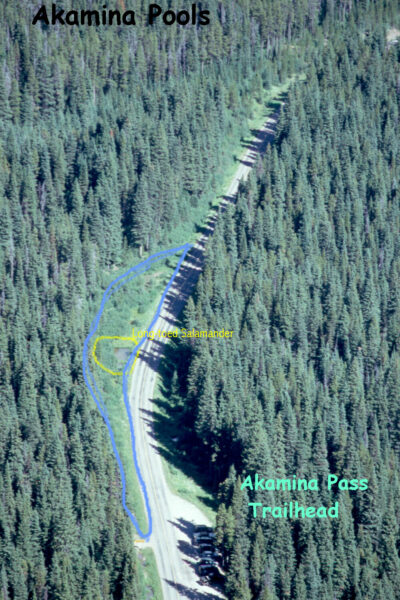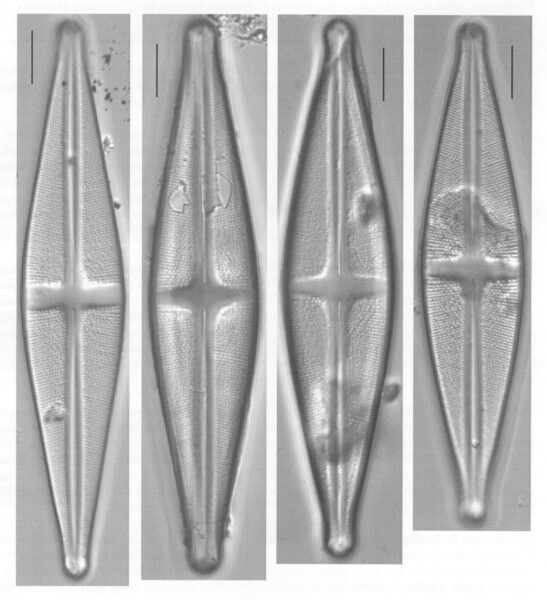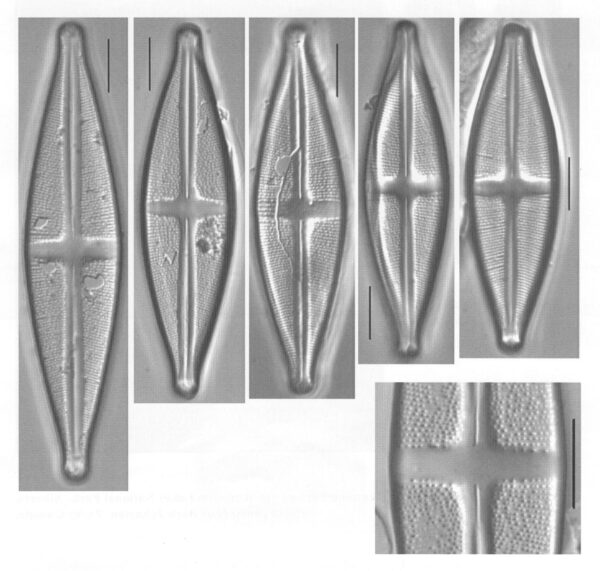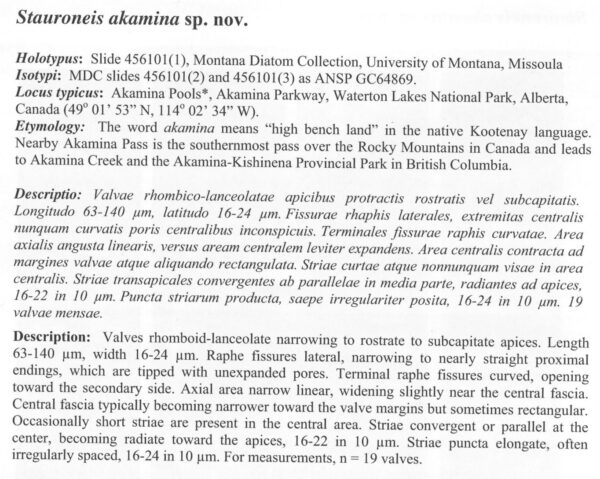Stauroneis akamina
-
Category
-
Length Range63-140 µm
-
Width Range16-24 µm
-
Striae in 10 µm16-22
-
ContributorLoren Bahls - Dec 2011
-
ReviewerSarah Spaulding - Apr 2012
Identification
Description
Valves rhomboid-lanceolate narrowing to rostrate to subcapitate apices. The raphe fissures are lateral, narrowing centrally. The proximal raphe ends are nearly straight with unexpanded pores. The terminal raphe fissures are curved, opening toward the secondary side. The axial area is narrow and linear, widening slightly near the stauros. The stauros typically becomes narrower toward the valve margin, but may be rectangular in some specimens. Occasionally, short striae are present in the central area. Striae are convergent or parallel at the center, becoming radiate toward the apices. The striae number 16-22 in 10 µm. Areolae are elongate and often irregularly spaced, numbering 16-24 in 10 µm (n = 19 valves).
Autecology
Stauroneis akamina is known from pools in Waterton Lakes National Park, from ponds and fens in Glacier National Park, and from wetlands in southwestern Montana. The pH of these waters ranges from 6.0 to 7.3 and specific conductance ranges from 25 to 71 µS/cm.
-
Size Range, µm3
-
Motility
-
Attachment
-
Habitat
-
Colony
-
Waterbody
- Learn more about this
Original Description
Valves rhomboid-lanceolate narrowing to rostrate to subcapitate apices. Length 63-140 µm, width 16-24 µm. Raphe fissures lateral, narrowing to nearly straight proximal endings, which are tipped with unexpanded pores. Terminal raphe fissures curved, opening toward the secondary side. Axial area narrow linear, widening slightly near the central fascia. Central fascia typically becoming narrower toward the valve margins but sometimes rectangular. Occasionally short striae are present in the central area. Striae convergent or parallel at the center, becoming radiate toward the apices, 16-22 in 10 µm. Striae puncta elongate, often irregularly spaced, 16-24 in 10 µm. For measurements, n = 19 valves.
-
AuthorBahls 2010
-
Length Range63-140 µm
-
Width16-24 µm
-
Striae in 10µm16-22
Citations & Links
Citations
Links
-
Index Nominum Algarum
Cite This Page
Bahls, L. (2011). Stauroneis akamina. In Diatoms of North America. Retrieved April 25, 2024, from https://diatoms.org/species/stauroneis_akamina
Responses
The 15 response plots show an environmental variable (x axis) against the relative abundance (y axis) of Stauroneis akamina from all the stream reaches where it was present. Note that the relative abundance scale is the same on each plot. Explanation of each environmental variable and units are as follows:
ELEVATION = stream reach elevation (meters)
STRAHLER = distribution plot of the Strahler Stream Order
SLOPE = stream reach gradient (degrees)
W1_HALL = an index that is a measure of streamside (riparian) human activity that ranges from 0 - 10, with a value of 0 indicating of minimal disturbance to a value of 10 indicating severe disturbance.
PHSTVL = pH measured in a sealed syringe sample (pH units)
log_COND = log concentration of specific conductivity (µS/cm)
log_PTL = log concentration of total phosphorus (µg/L)
log_NO3 = log concentration of nitrate (µeq/L)
log_DOC = log concentration of dissolved organic carbon (mg/L)
log_SIO2 = log concentration of silicon (mg/L)
log_NA = log concentration of sodium (µeq/L)
log_HCO3 = log concentration of the bicarbonate ion (µeq/L)
EMBED = percent of the stream substrate that is embedded by sand and fine sediment
log_TURBIDITY = log of turbidity, a measure of cloudiness of water, in nephelometric turbidity units (NTU).
DISTOT = an index of total human disturbance in the watershed that ranges from 1 - 100, with a value of 0 indicating of minimal disturbance to a value of 100 indicating severe disturbance.

Stauroneis akamina
- Areolae oblong and irregularly spaced
- Valves lanceolate, large
- Apices rostrate to subcapitate
- Proximal raphe ends straight
Stauroneis akamina has oblong areolae that are irregularly spaced. Valves are lanceolate and range from 63 to 140 µm long. Apices are rostrate to subcapitate. Proximal raphe ends are straight and not expanded.
 Diatoms of North America
Diatoms of North America









